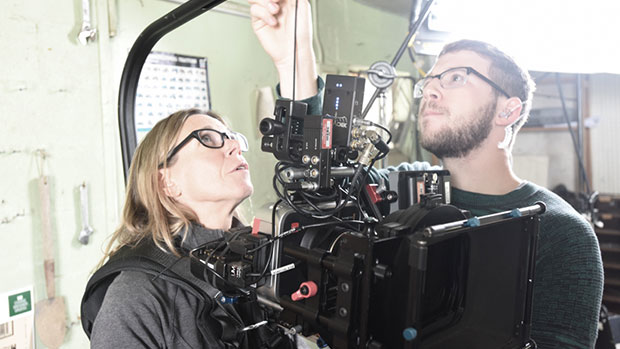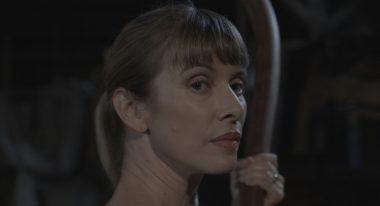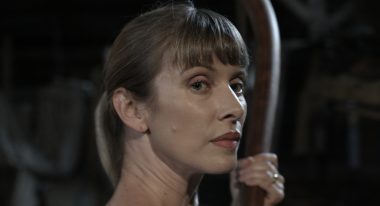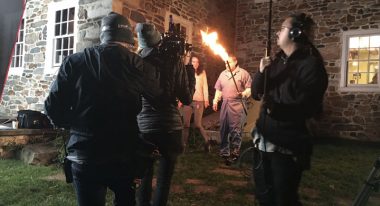 Back to selection
Back to selection
The Week In Cameras
Latest News About the Tools We Use by Michael Murie
DP Sherry McCracken on Cinematography vs Photography, Pre-Visualization and the Growing Ease of Equipment for Female Crew Members

In part two of this interview, DP of American Gothic Sherry McCracken discusses moving from photography to cinematography, what she’d do differently, and how lighter cameras make it possible for more women to work as cinematographers. You can read the first part of the interview here.
Filmmaker: How did you find it going from photography to cinematography?
McCracken: There are as many similar things as there are different things. I felt right at home with lens choice, ISO, aperture choice, sensor size, memory card speeds, etc. I was used to framing shots and lighting them for the best dynamic range and composition.
But when you take a photo, you wait for the moment to happen. With film, you set-up the moment you want to happen. Lighting becomes a massive task where you need to have a vast amount of knowledge about building light and blocking light to set the tone for the scene. Given our short production schedule, we had to shoot a lot of day-for-night so there were always lighting challenges. Having a great lighting director really helped me learn what I needed to think about and what lights and tools would get me the look our director wanted.
Camera movement was something new too. Learning when to use a stabilizer, dolly or jib was different for sure. Not only how you use the tools, but when and why to call for a jib or dolly. This is where my relationship with the director came in. We would talk through the characters and the intended emotional feel of the scene. We’d discuss what he wanted the audience to be feeling and what movement we should use to get that emotion.
I later saw how some of these choices came together in the edit and the power of movement…or stillness.

Filmmaker: Did you shoot any tests with the camera?
McCracken: One of the things that saved us so much money — besides buying our own equipment — was the fact that we did a pre-visualization of some of the big scenes. Doing this pre-visualization, even though we didn’t have the actual actors there and were just using some friends that wanted to help with the project, showed us we could shoot the kinds of scenes that we wanted to shoot. And that helped us confirm we could do this movie for this budget and validated that we had picked the right camera.
We also used DaVinci Resolve to do color correction, which was a great match with the Blackmagic camera. Our colorist had experience using Da Vinci and he was also part of our decision in buying the camera because he felt that it had a very good color space with good dynamic range, and would work well with the color correction even in the low light that we shot.

Filmmaker: What were you doing for lighting?
McCracken: We did have a lighting crew that we had used on another feature film, so we had a full lighting truck. I’d say we spent the most money on being able to light the movie in a way that was very cinematic.
Filmmaker: When will the movie be released?
McCracken: We are set for distribution this spring. We’ve pretty much finished it up and put all the finishing touches on it. We also renamed it — it was Bloodletting when we were shooting, and now it’s American Gothic.
Filmmaker: How did that happen?
McCracken: Working with our distributor, and showing it at a couple of film festivals, we got some feedback that Blood Letting may have sounded too gory for the audience that we wanted to come to this film.
Filmmaker: If you had to do it over again, is there anything you would do differently?

McCracken: I would have two cameras. This would save us time and money. While blocking and lighting set-up is happening, someone on the camera crew could be grabbing B-roll and inserts. We just ordered the new Blackmagic Ursa Mini Pro and I’m looking forward to having it on our next feature.
I would also buy a 24mm lens. We ended up borrowing one and it became my go-to lens for several scenes.
Filmmaker: Anything else you want to share?
McCracken: I am a smaller, 5’2″ kind of petite person, and I’m also older, and this is my first feature, and I just think that the equipment is getting more manageable for females; to be able to do feature film work is huge. And I really am excited about the opportunities that I think are ahead for women in the film industry, not only as directors, but now more as cinematographers, because I know it held me back, now being able to lift things and do the job that some of the guys would be doing.
You can be a great cinematographer and not be able to hoist some of the equipment that’s been out there, but now you can carry the camera, and have more opportunities to make films, and I think there’s a big need for that in the industry.
